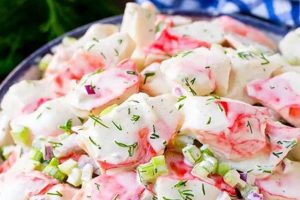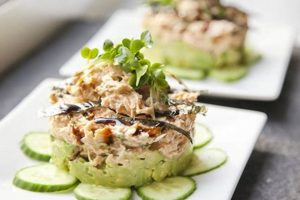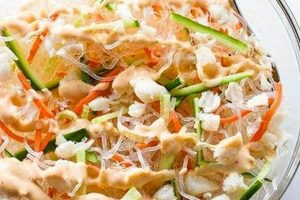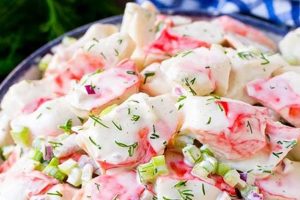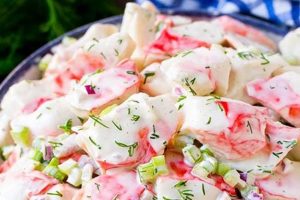A dish prepared by combining shredded imitation crab meat, typically made from surimi (processed white fish), with mayonnaise, and often other ingredients such as celery, onion, and seasonings. Variations may include the addition of hard-boiled eggs, relish, or mustard. This provides a cost-effective alternative to using real crab meat while offering a similar texture and a mildly sweet, oceanic flavor.
This type of salad offers an accessible and affordable way to enjoy a crab-like flavor. The use of surimi makes it a budget-friendly option compared to dishes using fresh or canned crab. It’s also a convenient choice, as imitation crab meat is readily available in most supermarkets and requires no pre-cooking. Historically, surimi-based products have roots in East Asian cuisine, where they were developed as a way to preserve and utilize fish. Modern imitation crab meat provides a convenient and shelf-stable version of this culinary tradition.
The following sections will explore various aspects of preparing this dish, including selecting ingredients, different recipe variations, tips for achieving optimal flavor and texture, and suggestions for serving.
Tips for Preparing Imitation Crab Salad
Achieving optimal flavor and texture in imitation crab salad involves careful consideration of ingredient selection and preparation techniques. These tips offer guidance for creating a delicious and satisfying dish.
Tip 1: Thaw and Drain Thoroughly: Ensure the imitation crab meat is fully thawed and any excess liquid is drained away. Residual moisture can dilute the salad’s flavor and create a watery consistency.
Tip 2: Fine Shredding: Shredding the imitation crab meat finely creates a better texture and allows it to blend more seamlessly with the other ingredients. Avoid large chunks, which can feel less integrated into the overall salad.
Tip 3: High-Quality Mayonnaise: The mayonnaise serves as the base of the salad, so using a high-quality product enhances the overall flavor profile. Consider experimenting with different types, such as olive oil or avocado oil mayonnaise.
Tip 4: Fresh Ingredients: Using fresh vegetables like celery and onion adds a crispness and brightness to the salad. Ensure they are finely chopped for optimal texture and even distribution.
Tip 5: Balanced Seasoning: Seasoning should enhance the natural sweetness of the imitation crab. A classic combination includes salt, black pepper, and a touch of Old Bay seasoning. Avoid over-seasoning, which can mask the delicate flavors.
Tip 6: Chill Before Serving: Chilling the salad for at least 30 minutes before serving allows the flavors to meld and creates a more refreshing dish. This also firms the salad, making it easier to serve.
Tip 7: Consider Textural Variety: Add chopped water chestnuts, diced bell peppers, or finely chopped apples for additional texture and flavor complexity.
By following these tips, one can create an imitation crab salad that offers a satisfying balance of flavor, texture, and freshness. Attention to detail in ingredient selection and preparation elevates this simple dish.
This exploration of preparation tips provides a foundation for crafting a delicious imitation crab salad. The concluding section will offer serving suggestions and variations to further enhance enjoyment of this versatile dish.
1. Ingredients
Ingredient selection significantly impacts the flavor, texture, and overall quality of imitation crab salad. Careful consideration of each component ensures a balanced and enjoyable culinary experience. The following facets explore key ingredient categories and their contributions to a successful recipe.
- Imitation Crab Meat
The primary component, imitation crab meat, provides the characteristic flavor and texture. Typically made from surimi, a processed fish paste, its quality varies depending on the brand and ingredients. Opting for a product with a higher percentage of surimi generally results in a firmer texture and a more pronounced seafood flavor. Lower-quality versions may contain more fillers and starches, leading to a softer, less flavorful outcome. The amount of imitation crab used also influences the overall richness of the salad.
- Mayonnaise
Mayonnaise serves as the binding agent and contributes a creamy richness. Its quality and type significantly influence the overall flavor profile. Traditional mayonnaise offers a classic taste, while options like olive oil or avocado oil mayonnaise introduce subtle nuances. The amount of mayonnaise used impacts the salad’s consistency, ranging from a lighter, fluffier texture to a denser, richer one. Adjusting the quantity allows for customization based on personal preference.
- Vegetables
Vegetables add textural complexity and freshness. Common choices include finely diced celery and onion, which provide a crisp counterpoint to the creamy mayonnaise and imitation crab. Other options, such as diced bell peppers, chopped water chestnuts, or shredded carrots, offer additional flavor and textural dimensions. The quantity and variety of vegetables incorporated allow for customization based on individual preferences and desired flavor profiles.
- Seasonings
Seasonings enhance and balance the inherent flavors of the other ingredients. A classic combination involves salt, black pepper, and a touch of Old Bay seasoning, which complements the imitation crab’s delicate sweetness. Other additions might include Dijon mustard, lemon juice, or a dash of hot sauce, providing complexity and depth. Careful balancing of seasonings is crucial to avoid overpowering the subtle flavors of the imitation crab and other components.
The interplay of these ingredient categories determines the final character of the imitation crab salad. A thoughtful approach to selection and proportioning creates a harmonious blend of flavors and textures, resulting in a satisfying and enjoyable dish.
2. Preparation
Preparation plays a crucial role in the final outcome of an imitation crab salad recipe. It directly influences the texture, flavor integration, and overall presentation. Careful preparation elevates this simple dish, transforming readily available ingredients into a cohesive and enjoyable culinary experience. A systematic approach to preparation ensures consistent results and maximizes the potential of the chosen ingredients.
Consider the impact of properly thawing and draining the imitation crab meat. Failure to remove excess moisture can result in a watery salad, diluting the flavors and compromising the texture. Conversely, thorough draining allows the other ingredients, such as mayonnaise and seasonings, to adhere properly, creating a balanced and flavorful blend. Similarly, the method of shredding the imitation crab influences the final texture. Finely shredded crab integrates seamlessly with the other components, contributing to a cohesive and pleasant mouthfeel. Coarsely shredded crab, on the other hand, can create a disjointed texture and detract from the overall experience. The preparation of other ingredients, like chopping vegetables to a uniform size, also contributes to a visually appealing and texturally satisfying salad. Evenly sized pieces ensure even distribution of flavors and prevent any one ingredient from dominating.
Practical applications of meticulous preparation extend beyond the immediate sensory experience. Proper food handling techniques, such as maintaining a clean work surface and refrigerating ingredients promptly, contribute to food safety and prevent bacterial growth. Efficient preparation methods, like prepping ingredients in advance, can streamline the cooking process, making it more manageable and less time-consuming. Ultimately, thoughtful preparation ensures a successful imitation crab salad that delivers on flavor, texture, and food safety, highlighting the integral role of preparation in achieving culinary excellence.
3. Flavor Balance
Flavor balance represents a critical aspect of a successful crab salad recipe using imitation crab. It distinguishes a bland, uninspired dish from a vibrant and enjoyable culinary creation. Achieving this balance involves a nuanced understanding of the inherent flavors of the core ingredients and how they interact with seasonings and other components. The following facets explore the key elements contributing to a harmonious flavor profile in imitation crab salad.
- The Delicate Sweetness of Imitation Crab
Imitation crab, derived primarily from surimi (processed white fish), possesses a naturally mild, slightly sweet flavor. This subtle sweetness serves as the foundation upon which other flavors are built. Overpowering this delicate base with strong seasonings can mask the inherent character of the imitation crab, resulting in a less nuanced and enjoyable salad. Recognizing the subtle sweetness allows for informed decisions regarding complementary flavor pairings and appropriate seasoning levels.
- The Role of Acidity
Acidity plays a pivotal role in balancing the sweetness of the imitation crab and adding brightness to the overall flavor profile. A touch of lemon juice or a splash of white wine vinegar can lift the flavors, preventing the salad from becoming overly sweet or cloying. The acidity also interacts with the mayonnaise, adding a tangy complexity and enhancing the overall balance. The careful application of acidic elements prevents the salad from becoming too tart, maintaining a harmonious flavor profile.
- Savory and Umami Notes
Savory and umami notes add depth and complexity to the flavor profile. Ingredients like Dijon mustard, Worcestershire sauce, or a pinch of Old Bay seasoning contribute these savory elements, complementing the sweetness of the imitation crab and creating a more well-rounded flavor experience. These savory elements provide a counterpoint to the sweetness and acidity, enhancing the overall balance and creating a more satisfying dish.
- The Importance of Seasoning Restraint
While seasonings enhance the flavors of the other ingredients, restraint is crucial in achieving a balanced flavor profile. Over-seasoning can mask the delicate sweetness of the imitation crab and other subtle flavors. A light hand with salt and pepper, along with judicious use of other spices and herbs, allows the natural flavors of the ingredients to shine through. This approach creates a more nuanced and enjoyable salad, highlighting the interplay of flavors rather than overpowering them.
By understanding these facets of flavor balance, one can create an imitation crab salad that showcases the subtle sweetness of the imitation crab while incorporating complementary flavors that enhance the overall experience. This balanced approach results in a dish that is not only flavorful but also demonstrates an appreciation for the nuances of culinary artistry. A well-balanced imitation crab salad offers a refreshing and satisfying culinary experience, highlighting the interplay of textures and tastes.
4. Texture
Texture plays a significant role in the overall enjoyment of imitation crab salad. It contributes to the sensory experience, influencing perceptions of freshness, quality, and overall appeal. A successful imitation crab salad offers a balanced textural profile, engaging multiple senses and enhancing the dining experience. The following facets explore key textural elements and their contributions to a well-executed dish.
- The Role of Imitation Crab
Imitation crab, typically made from surimi, possesses a naturally tender, slightly flaky texture. Its texture can vary depending on the quality and processing methods. Higher-quality imitation crab tends to have a firmer, more resilient texture, while lower-quality versions can be softer and more mushy. The texture of the imitation crab forms the foundation of the salad’s overall textural profile.
- Balancing Creamy and Crisp Elements
The interplay of creamy and crisp textures creates a dynamic and enjoyable sensory experience. The mayonnaise provides the creamy element, binding the ingredients and contributing a smooth mouthfeel. Crisp elements, typically from finely diced vegetables like celery and onion, offer a contrasting texture, adding a refreshing crunch. This balance prevents the salad from becoming overly creamy or monotonous, enhancing the overall enjoyment.
- The Impact of Chopping Techniques
Chopping techniques significantly influence the textural profile. Uniformly diced vegetables ensure even distribution of textures throughout the salad. Finely chopped ingredients create a more delicate texture, while coarsely chopped ingredients provide a more substantial bite. The chosen chopping technique allows for customization based on individual preferences and desired textural outcomes.
- Enhancing Textural Variety
Incorporating additional ingredients can further enhance the textural variety. Chopped water chestnuts, for example, introduce a crisp, slightly sweet element. Diced bell peppers offer a firm, juicy crunch. These additions contribute to a more complex and engaging textural profile, elevating the overall dining experience.
The careful consideration of these textural elements contributes significantly to the overall enjoyment of imitation crab salad. A balanced and varied textural profile enhances the sensory experience, making the dish more appealing and satisfying. The interplay of textures, from the tender flakiness of the imitation crab to the crispness of the vegetables, creates a dynamic and enjoyable culinary experience.
5. Serving Suggestions
Serving suggestions represent a crucial element within the context of a crab salad recipe utilizing imitation crab. They provide a framework for presenting the dish in various formats, maximizing its versatility and appeal. Understanding the connection between serving suggestions and the inherent qualities of imitation crab salad allows for informed choices that elevate the dining experience. Serving suggestions influence not only presentation but also how the flavors and textures of the salad are perceived and enjoyed.
Consider the classic presentation of imitation crab salad as a sandwich filling. Served on lightly toasted bread or a croissant, the creamy texture of the salad complements the bread’s structure, creating a satisfying contrast. The subtle sweetness of the imitation crab harmonizes with the savory notes of the bread, resulting in a balanced flavor profile. Alternatively, serving the salad in lettuce cups offers a lighter, more refreshing option. The crisp lettuce provides a textural counterpoint to the creamy salad, enhancing the overall sensory experience. This serving method also caters to dietary preferences for low-carbohydrate or gluten-free options. Further extending the versatility, imitation crab salad can be used as a filling for stuffed avocados or tomatoes. The richness of the avocado complements the creamy salad, while the acidity of the tomato provides a refreshing contrast. These examples demonstrate the adaptability of imitation crab salad and the importance of choosing a serving method that complements its inherent qualities.
Effective serving suggestions consider not only the salad itself but also the overall dining occasion. For a casual lunch, a simple sandwich or lettuce wrap might suffice. For a more formal setting, presenting the salad in elegant serving dishes or as part of a composed plate adds a touch of sophistication. Garnishing with fresh herbs, a sprinkle of paprika, or a wedge of lemon elevates the presentation further, enhancing visual appeal and stimulating the appetite. Ultimately, thoughtfully chosen serving suggestions transform a simple imitation crab salad recipe into a versatile and enjoyable culinary experience, adaptable to various occasions and individual preferences. They provide a framework for showcasing the salad’s flavors and textures, maximizing its potential and ensuring a satisfying dining experience.
6. Variations
Variations within imitation crab salad recipes demonstrate the dish’s adaptability and potential for culinary exploration. They highlight the interplay of core ingredients with complementary flavors and textures, offering a range of possibilities beyond the basic formula. Understanding the impact of variations allows for customization based on individual preferences, dietary restrictions, and available ingredients. This exploration considers the cause-and-effect relationship between ingredient modifications and the resulting flavor profiles, emphasizing the practical significance of such variations.
Consider the addition of diced apples or grapes. These fruits introduce sweetness and a contrasting textural element, creating a lighter, more refreshing salad. The sweetness complements the inherent mild sweetness of the imitation crab, while the crisp texture of the fruit contrasts with the creamy mayonnaise. Alternatively, incorporating ingredients like chopped jalapeos or a dash of hot sauce introduces heat, adding complexity to the flavor profile. The heat balances the sweetness and provides a more dynamic sensory experience. Similarly, the use of different herbs and spices, such as dill, chives, or Old Bay seasoning, allows for further customization of the flavor profile. Dill adds a bright, slightly tangy note, while chives contribute a subtle onion flavor. Old Bay seasoning, a blend of spices including celery salt, paprika, and red pepper flakes, provides a savory depth. These examples demonstrate how variations in ingredients directly impact the overall flavor and textural experience of the imitation crab salad.
Variations extend beyond flavor profiles to accommodate dietary needs and preferences. Substituting plain Greek yogurt for a portion of the mayonnaise reduces the overall fat content while maintaining a creamy texture. Using gluten-free bread or lettuce wraps caters to gluten-free diets. These adaptations maintain the essence of the dish while addressing specific dietary requirements. Ultimately, exploring variations within imitation crab salad recipes unlocks a range of possibilities, transforming a simple dish into a versatile culinary canvas. Understanding the impact of ingredient modifications empowers informed choices, ensuring a satisfying and personalized dining experience.
Frequently Asked Questions
This section addresses common inquiries regarding imitation crab salad, providing concise and informative responses to clarify potential uncertainties and enhance understanding of this versatile dish.
Question 1: What is imitation crab meat made of?
Imitation crab meat, also known as surimi, is typically made from processed white fish, such as pollock or cod. It is blended with starches, flavorings, and colorings to mimic the flavor, texture, and appearance of real crab meat.
Question 2: Is imitation crab salad healthy?
Imitation crab salad can be part of a healthy diet when consumed in moderation. It is a good source of protein but can be high in sodium and processed ingredients. Nutritional content varies depending on the specific recipe and ingredients used.
Question 3: How long does imitation crab salad last in the refrigerator?
Properly stored in an airtight container, imitation crab salad typically lasts for 3-5 days in the refrigerator. Discard any salad that shows signs of spoilage, such as an off odor or discoloration.
Question 4: Can imitation crab salad be frozen?
Freezing imitation crab salad is not recommended. Freezing negatively impacts the texture of the mayonnaise and other ingredients, resulting in a watery and less palatable salad upon thawing.
Question 5: What are some alternatives to mayonnaise in imitation crab salad?
Alternatives to mayonnaise include plain Greek yogurt, avocado, or a mixture of olive oil and lemon juice. These options offer different flavor profiles and can reduce the overall fat content.
Question 6: How can one enhance the flavor of imitation crab salad?
Flavor enhancement can be achieved through various methods. Incorporating fresh herbs like dill or chives adds brightness. Spices such as Old Bay seasoning contribute depth. A touch of lemon juice or vinegar provides acidity. Experimentation with different seasonings and ingredients allows for personalized flavor profiles.
Understanding these common inquiries facilitates informed choices regarding ingredient selection, preparation methods, and storage practices, ultimately contributing to a more satisfying and enjoyable culinary experience with imitation crab salad.
This FAQ section concludes the comprehensive exploration of imitation crab salad. The provided information equips readers with the knowledge to create and enjoy this versatile dish.
Crab Salad Recipe with Imitation Crab
This exploration has provided a comprehensive overview of crab salad recipes utilizing imitation crab. Key aspects discussed include ingredient selection, highlighting the importance of quality mayonnaise and fresh vegetables; preparation techniques, emphasizing proper thawing and shredding of the imitation crab; flavor balance, focusing on the interplay of sweetness, acidity, and savory notes; textural considerations, balancing creamy and crisp elements; serving suggestions, ranging from classic sandwiches to innovative presentations; and variations, demonstrating the dish’s adaptability through ingredient substitutions and additions. Each facet contributes to a holistic understanding of this versatile and accessible dish.
Crab salad prepared with imitation crab offers a cost-effective and convenient approach to enjoying a crab-like flavor experience. Careful consideration of ingredients and preparation methods elevates this simple dish, transforming readily available components into a satisfying culinary creation. Continued exploration of variations and serving suggestions allows for personalized adaptations, ensuring a consistently enjoyable and adaptable meal option.

